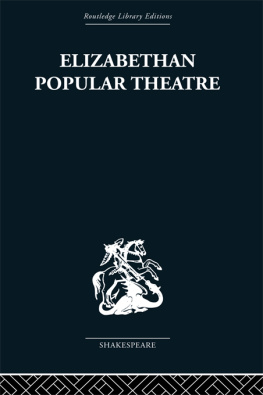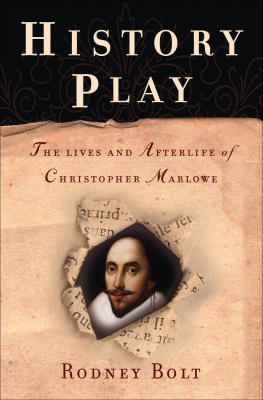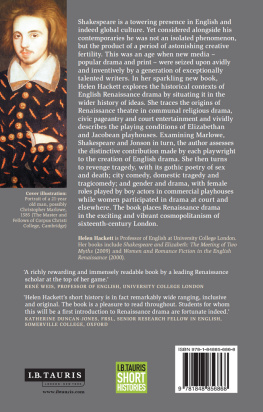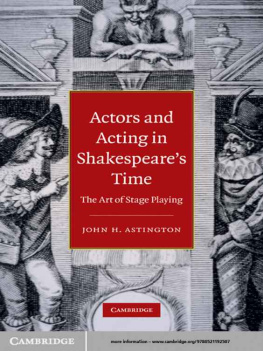
Routledge Library Editions
ELIZABETHAN POPULAR THEATRE

Routledge Library Editions Shakespeare
PERFORMANCE
In 4 Volumes
| I | Changing Styles in Shakespeare | Berry |
| II | Elizabethan Popular Theatre | Hattaway |
| III | Old Vic Prefaces | Hunt |
| IV | Shakespeares Dramatic Heritage | Wickham |
ELIZABETHAN POPULAR THEATRE
Plays in Performance
MICHAEL HATTAWAY

First published in 1982
Reprinted in 2005 by
Routledge
2 Park Square, Milton Park, Abingdon, Oxon, OX14 4RN
Routledge is an imprint of the Taylor & Francis Group
Transferred to Digital Printing 2008
1982 Michael Hattaway
All rights reserved. No part of this book may be reprinted or reproduced or utilized in any form or by any electronic, mechanical, or other means, now known or hereafter invented, including photocopying and recording, or in any information storage or retrieval system, without permission in writing from the publishers.
The publishers have made every effort to contact authors/copyright holders of the works reprinted in Routledge Library Editions Shakespeare. This has not been possible in every case, however, and we would welcome correspondence from those individuals/companies we have been unable to trace.
These reprints are taken from original copies of each book. In many cases the condition of these originals is not perfect. The publisher has gone to great lengths to ensure the quality of these reprints, but wishes to point out that certain characteristics of the original copies will, of necessity, be apparent in reprints thereof.
British Library Cataloguing in Publication Data
A CIP catalogue record for this book is available from the British Library
Elizabethan Popular Theatre
ISBN10: 0415353173 (hbk)
ISBN10: 0415489016 (pbk)
ISBN13: 9780415353175 (hbk)
ISBN13: 9780415489010 (pbk)
Miniset: Performance
Series: Routledge Library Editions Shakespeare
Publishers Note
The publisher has gone to great lengths to ensure the quality of this reprint but points out that some imperfections in the original may be apparent
Elizabethan Popular Theatre
Plays in Performance
Michael Hattaway

First published in 1982
by Routledge & Kegan Paul Ltd
39 Store Street, London WCIE 7DD,
9 Park Street, Boston, Mass. 02108, USA,
296 Beaconsfield Parade, Middle Park,
Melbourne, 3206, Australia, and
Broadway House, Newtown Road,
Henley-on-Thames, Oxon RG9 1EN
Set in Plantin, 10 on 12pt, by
Rowland Phototypesetting Ltd, Bury St Edmunds, Suffolk
and printed in Great Britain by
St Edmundsbury Press, Bury St Edmunds, Suffolk
Plates printed by
Headley Brothers Ltd, Ashford, Kent
Michael Hattaway 1982
No part of this book may be reproduced in any form without permission from the publisher, except for the quotation of brief passages in criticism
Library of Congress Cataloging in Publication Data
Hattaway, Michael.
Elizabethan popular theatre.
(Theatre production studies)
Bibliography: p.
Includes index.
1. Theater England History 16th century.
2. English drama Early modern and Elizabethan, 15001600 History and criticism. I. Title. II. Series.
PN2589.H33 792.0942 82-5429
ISBN 0-7100-9052-8
Contents
Illustrations
(between pages 86 and 87)
Preface and acknowledgments
The dates I have ascribed to the plays I mention come, unless stated otherwise, from Schoenbaums revision of A. Harbage, Annals of English Drama. I have been my own editor and modernised all quotations from dramatic and literary texts, having derived them from the standard editions of the works concerned.
Professor John Russell Brown, the general editor of the series, provided admirable encouragement and criticism as the writing progressed. At Kent R. A. Foakes, Kate McLuskie and Peter Davison read parts of the manuscript and weeded out numerous errors and infelicities as well as suggesting additional references. The typists of Eliot College deciphered my preternaturally untidy typescripts. To them and to librarians at Kent, the Universities of Massachusetts at Amherst and Texas at Austin (where Professor Lynda Boose offered me generous hospitality while I was in the last throes of revision), Harvard, Yale and the British Library I am exceedingly grateful.
I am grateful for permission to reproduce the following: , Bibliothque royale Albert Ier, Brussels (Cabinet des Estampes). Copyright is retained by the owners of the originals.
Introduction
This study of the popular drama of the late Elizabethan age begins with an account of the stages, performance conditions, and acting of the period and then turns to the analysis of five well-known plays of the 1590s. Two were written by Marlowe, a university-educated man, one (Mucedorus) by an anonymous disciple of the university wits, one by Kyd who, after leaving Merchant Taylors School, may have become a scrivener like his father, and the last by Shakespeare Titus Andronicus, a play that displays its authors impressive knowledge of the classics, of Seneca, Ovid, and even Euripides. A reader might be surprised to be reminded at the outset of a discussion of popular theatre of the academic origins of these works. However, an informing proposition of this book is that the value and popularity of this drama owe something to its traffic between the academic and the demotic, the idealized forms of the court show and the energies of carnival, between official subsidized private performance and licensed commercial public performance, between a literary and an oral culture. To the Elizabethans, in fact, public and popular were virtually synonymous: Sir Thomas Elyot noted that public was derived from populus, in which word is contained all the inhabitants of a realm or city, of what estate or condition so ever they be. (dramatized, say, in Beaumonts The Knight of the Burning Pestle written for an elitist audience about 1608) had not really begun before the turn of the century. Plays and players, the abstract and brief chronicles of the time, were, like sermons (their rivals as entertainment), important components of a mass culture.
Drama for the people therefore is one definition of popular drama. Another might be drama of the people. Study of theatrical conditions reveals not only that plays were occasions for community revelry but that texts were enlivened in performance by elements of aristocratic game and folk ritual. Moreover, although it is a dangerous generalization, I would argue that the ethos of these plays is sceptical and anti-authoritarian (although not anti-aristocratic) or, less attractively, chauvinistic and anti-Catholic.
Writers on Elizabethan drama have, until recently, tended to go to literary and printed sources, to philosophic and theological tracts, and too often have turned Marlowe, Shakespeare, and their fellows into Tudor propagandists, apologists for establishment order or the Elizabethan world picture. Certainly we find order restored at the end of many of these plays, but they also expose what Elizabethans associated with the politician, corruption wrought by acquisitiveness, and the machinations for power in the courts and cities where the dramas are set. Playwrights like Marlowe used the art of the theatre to depict the theatricality of politics; ceremonies are frequently disrupted to signify the vanity of power sustained by theatrical form. Heroes in these plays tend to be outsiders lovers, warriors, knaves, or saints and the sheer energy demanded for the performance of these roles must have raised the consciousness of contemporary audiences against all that is destructive of individuality. Energy is Eternal Delight said the voice of the devil through Blake, and delight may be the prime theatrical response here, a response that subverts the reactions predicted by literary theorists, the fear kindled by tragedy and the moralism of satiric comedy.
Next page









